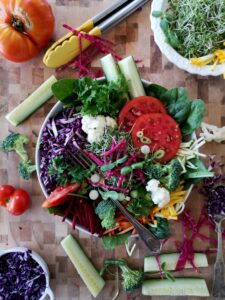For many of us navigating the food landscape can be a challenge, often filled with emotion.
Today, we welcome back to WOT Maya Feller MS, RD, CDN. Maya previously wrote for WOT about Sugar and Inflammation, and today, she is back to dive deeper into the addictive nature of sugar.
Convenience and ready-to-eat foods are readily available, easy to access, and inexpensive. Packaged goods, especially ones that are rich in added sugars, salts, and synthetic fats, are engineered so they are intentionally easy to consume. Most packaged foods were specifically designed to target the “bliss point,” a point of peak pleasure that will encourage you to reach for more and more. [1] This bliss point can override internal hunger and satiety mechanisms, telling you to consume more of the manufactured food product.[2]

The bliss point refers to the ratio of sugar, salt, and fat in a product -and is driven by the idea that we as humans crave foods high in these elements based on survival. Think back to our ancestors who had scarce amounts of food and never knew where the next meal was coming from. Foods high in sugar and fat would provide plenty of calories as they awaited their next meal, so it makes sense that people would crave these foods to enhance their odds of survival.

This bliss point doesn’t just refer to foods like cake, ice cream, and cookies. Food manufacturers have been using this principle to enhance the flavors of everyday products that one wouldn’t normally associate with sugar and fat. These foods include products like – salad dressing, tomato sauce, and even canned soups. Almost 75% of the food in the grocery store has added sugar, further solidifying the idea that many packaged goods are designed to make you, the consumer, desire them.
By knowing that many foods are designed to be overconsumed and that sugar is added to many packaged food products, you can use this information to be an informed consumer as you grocery shop. It can help you to make intentional choices about the foods you place in your cart or basket.
Intentionally reducing your intake of sugar-sweetened foods takes both intention and perseverance. And the journey will look different for each person, no one size fits all. There is some compelling research[3] to suggest that sugar might have addictive properties, lighting up the pleasure centers in your brain upon consumption.
Similar research suggests that similar to addictive substances, you will likely need to consume more sugar to elicit the same pleasurable effect.[4] As with any substance, even coffee, you may experience withdrawal symptoms when reducing your sugar intake.[5] Some of the commonly reported side effects include irritability, brain fog, reduced energy, and enhanced cravings.[6 For many, these side effects subside quickly. While the majority of these studies on sugar and addiction have been done on animals, we can use this information to enhance our understanding of why it can be so hard to decrease sugar intake.

To reduce your added sugar intake, try to shift the focus from what you’re cutting out to what you can add to your diet in place of foods with added sugars. Think about ways you can add fruits and vegetables that you enjoy into your routine. Do your best to nourish yourself with well-balanced meals that supply protein, fat, and carbohydrates to help keep blood sugar leveled, further reducing the feelings of highs and lows. Hydration is essential to every function that happens within your body. You can jazz up your water by steeping and cooling herbal and fruit teas, or infuse your water with herbs.
It takes time for the palate to adjust to foods without added sugars. The good news is that with decreased consumption of added sugar, your taste buds may shift to taste more of the flavors in all foods and sweetness from naturally sweet foods. Ask yourself, now that you have learned about the bliss point and added sugar in many foods, what is one thing you can add to your daily routine to increase the nutrient content?
— Maya Feller MS, RD, CDN
You can follow Maya on Instagram here!

About Maya Feller
Maya Feller, MS, RD, CDN of Brooklyn-based Maya Feller Nutrition is a registered dietitian nutritionist who is a nationally recognized nutrition expert. In her practice, she provides medical nutrition therapy for the management of and risk reduction of non-communicable diseases. Maya received her Masters of Science in clinical nutrition at New York University, where she is adjunct faculty. Whether addressing the nation or working one on one and with groups, Maya believes in providing nutrition education from an antibias patient-centered, culturally sensitive approach. Maya is dedicated to promoting nutrition education that helps the public to make informed food choices that support health and longevity. Maya shares her approachable, real food based solutions to millions of people through regular speaking engagements, writing in local and national publications, via her social media account on Instagram, @mayafellerRD, and as a national nutrition expert on Good Morning America, GMA3: What You Need to Know and more.She is the author of The Southern Comfort Food Diabetes Cookbook: Over 100 Recipes for a Healthy Life.
[1] https://www.npr.org/sections/thesalt/2015/12/16/459981099/how-the-food-industry-helps-engineer-our-cravings
[2] https://www.cnn.com/2019/03/19/health/bliss-point-addictive-food/index.html
[3] https://pubmed.ncbi.nlm.nih.gov/28835408/
[4] https://www.ncbi.nlm.nih.gov/pmc/articles/PMC3139704/
[5] https://www.ncbi.nlm.nih.gov/pmc/articles/PMC3139704/
[6] https://www.healthline.com/health/sugar-detox-symptoms#symptoms


















